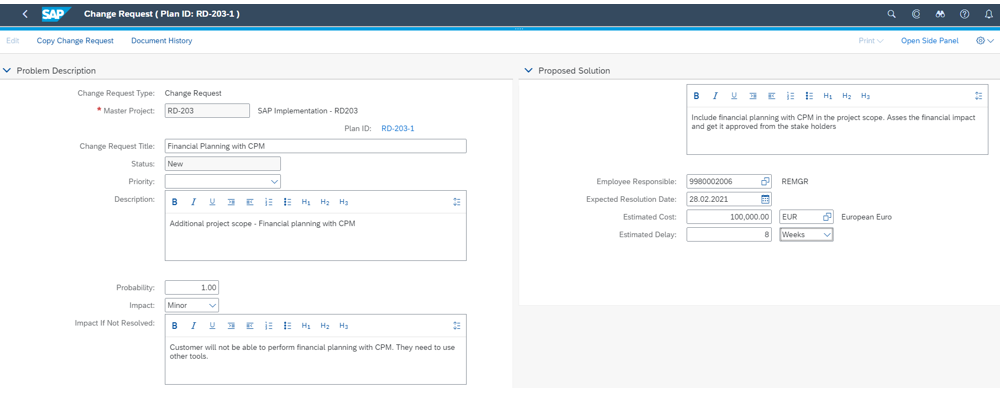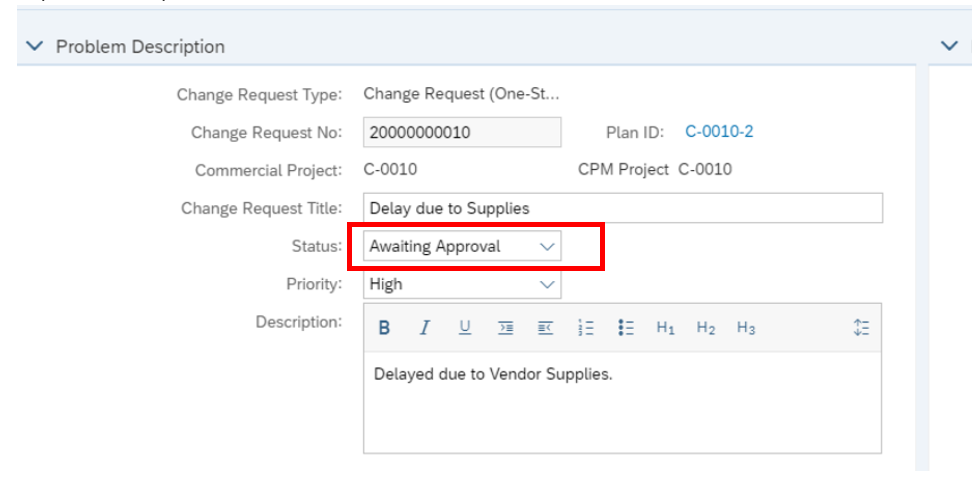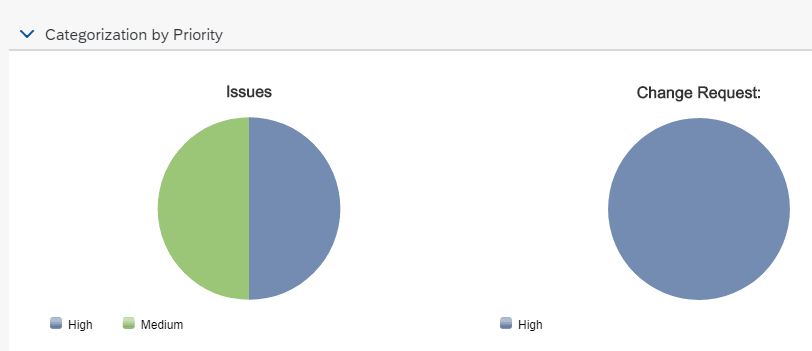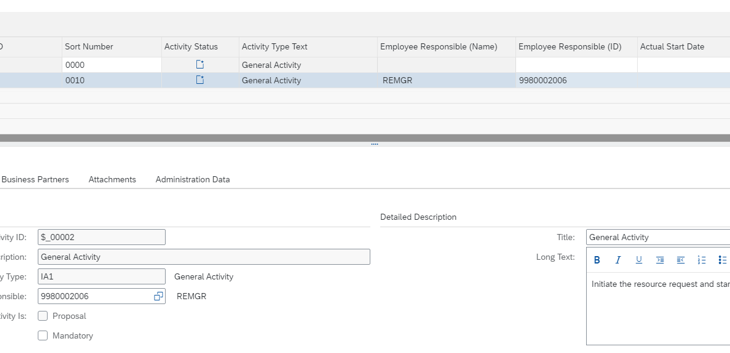Introduction
This blog gives an overview of the functionality available in Commercial Project Management to capture project issues and change request arising in a project.
User Role – Project Manager / Project Planner
Issues and change requests are inevitable during the life cycle of a project. There are many issues identified which need to be handled before they become a risk for the project. Also, there are changes which affect the project duration, quality, and cost. There are many reasons for issues and changes to happen on the projects and few of the most common ones are listed below –
- Change in the scope of the project during execution
- Non-availability of resources or delay in the procurement
- Compliance related issues and changes
- Force Majeure
Project stakeholders should be able to manage these issues and change requests effectively so that effects due to the same can be minimized on the duration, quality, and cost of the project. They should also be able to track the changes along with their financial impact on the project during the complete life cycle of the project.
Traditionally, project teams didn’t have appropriate tools to manage issues and change requests arising on a project. Generally, teams use tools like excel spreadsheets, paper-based documents, emails, or some standalone software where information is not integrated with the applications managing project details (financials, schedule etc.). There have been many drawbacks due to the missing integration between application managing project and project issues & change requests and few of the common ones are given below –
- Inefficient paper-based or excel-based processes. No single source of truth which is available to all the project stake holders (internal / external)
- Inconsistent recording of issues and change requests. Incomplete documentation and information.
- Long cycle to review and approve changes
- Missing integration between applications (Issues & Changes and Project). This may also affect project budget and cost overrun.
- Inefficient tracking of changes during project life cycle.
Project Issue and Change Management in Commercial Project Management can help project stake holders to identify, document, communicate and track issues and changes. The financial impact due to the same can be estimated and sent for approval before these changes are implemented.
Project Issue and Change Management (CA-CPD-PCM) provides users with the following features:
- Processing of issues and change requests relevant to different types of business objects (PS objects, financial plans, purchase requisitions, sales orders, CRM opportunities, SAP Portfolio and Project Management objects, or DMS documents)
- Integration with the multiple application components in SAP S/4HANA to allow the possibility to exchange data and post updates
- Cost and revenue planning of changes using Project Cost and Revenue Planning in CPM
- Documentation and processing of project issues and changes using DMS documents, reference URLs, and attachments (such as word processing documents, spreadsheets, drawings)
- Monitoring of issues and change requests using the issue and change log
- Multi-level approval process for change requests
- Reporting and analytics

The picture above explains the complete process to manage issues and change requests arising on the projects. Let’s have a look at the process to manage issues and change requests in Commercial Project Management in more details.
Issue Management – Project Issue and Change Management allow users to log issues in the system so that users can document project deviations and reduce the effects of changes in quality, schedule, and costs of the project.
There is a dedicated app to report issues in the project which means you don’t need to go into your master project to report issues. However, master project should exist before you can create issues against it. User will be asked to enter the master project as it a mandatory field.

Users can also go into project workspace and report Issues and Change requests for the master project. However, user has to select if he / she wants to report issue or a change request in this case. Since, issue is triggered within the project workspace, master project will be automatically selected in this case.

- First step while reporting an issue is to select the issue type from the pre-defined list. Issue types are configurable so additional issue types can always be added into the list as required. Issue types are mainly used for reporting and to assign person responsible based upon the type of the issues.

- Master project is a mandatory field to link the issue with the project. So, it must be entered. Please create a master project if it has not been created so far. Apart from that, information (Issue Title, Priority, Issue Description, Impact, Impact Description, estimated cost impact, delay on the project, Expected Resolution Date and Proposed Solution) as shown below should be updated while creating an issue. Employee, who is, responsible for the resolution of this issue should be entered as well.

- Apart from employee responsible, additional partners can be added as well. All these partners can be notified by email upon creation of the issue. External partners like customers / vendors can be notified as well.

- Issues can also be linked with various reference objects like project object (WBS Element, Network, Activity etc.), purchase order, sales order, CRM opportunity or another project issue etc. Issues can be linked to more than one object. This can help in determining the affected objects and stake holders in case issues are not resolved on time.

- The most important step is to create activities (tasks) to resolve the issue and assign processors to the same. More than one activity can be created against an issue and assigned to a different processor. Status of the activity can be managed to check if the activity has been completed or not. Workflows can be triggered to notify / remind the responsible person about the open activities.

Documents and URLs can also be assigned to the issues. Save the issue once all the necessary information has been entered. System will generate an internal number and assign to the issue. Once issue has been reviewed by the authorized person, status can be changed to “In Process”.
All the issues and change requested created against the master project are displayed in the project workspace. Users can always go into any issue to check the current status. Progress on the issues can also be updated along with the status of the same.

Change Request Management – Change Request Management also has a dedicated app to directly create change requests. However, user can initiate change requests from the project workspace as shown above in issue management.

Change requests can be created with one level or two levels of approval as shown below. Workflows can be used to send the notifications to the relevant approvers and get the change requests approved. Once approved, Status of the change request can be changed to “in process”.

Information, as shown below, should be entered into the change request before it is sent for approval. Master project is mandatory to be entered while creating a change request. So, it should be created beforehand. Master project will be automatically selected while creating change requests from the project workspace.

- Change request should be linked to a reference object like a WBS element or Network activity so that financial planning can be done against the same. This is an important step because updated financial impact on the project should be replicated back into SAP S/4HANA.

- Additional partners can be assigned apart from the employee responsible for the change request. The process to assign additional partner remains the same as already explained in issue management. It is important to have additional partner assigned to the change request if multi-level approval is needed. It is helpful while defining workflow for the change request. Also, all the relevant stakeholders should be informed while creating / processing a change request on the project.
- The most important step while creating a change request is to perform financial planning to assess and understand the impact on the cost of the project.
To initiate financial planning, go into “Cost Estimation Alternatives”, expand the node and select the activity with description “First Alternative” and click on “Launch Financial Planning”.

The further process to perform financial planning is explained in the blog “SAP S/4HANA: Financial Planning with Commercial Project Management”. The link for the same is given below.
Note: It is important to highlight that functionality related to Claim Management in SAP S/4HANA is not considered as the target architecture. That’s why, it is recommended to use Project Issue and Change Management to manage any requirement related to claim management.
Save the change request once financial planning is completed. Initiate the approval process by changing the status of the change request to “Awaiting Approval”. This creates an activity to trigger approval process. After approval, status of the change request will be updated to “Approved”

All the issues and change requests created against the master project are displayed in the project workspace both in graphical and list display.


User can get into individual issue or change request from any of the views.
This was a brief overview on the process related to issue and change management in commercial project management.










